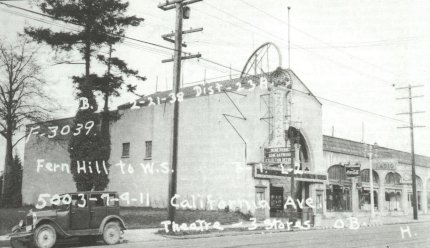


Granada (Egyptian) Theatre - 2/7 Wurlitzer
Seattle, Washington
5011 California Avenue SW
Organ installation timeframe: 1926 - 1939
Back to the Washington Original Theatre Installations page

The Granada Theater, c. 1938, with its distinctive marquee, as described in the July 22, 1926, West Seattle Herald: "It imitates a skyrocket which comes flaming over the roof and ends in a burst of stars at the entrance, where the word 'Granada' is emblazoned in light."
The Granada Theatre was located in West Seattle. It originally had a 2/7 Wurlitzer, opus 1194 installed in 1926 that was first shipped to the San Francisco Wurlitzer store in 1925.
Miss Nellie Dean Mitchell was organist at the Granada in 1926-27.
The organ was later moved in 1939 to KOMO Radio and then sold to Bennett Fisher of Des Moines.
The theatre operated as the "Egyptian" for a number of years.
Another, larger instrument was installed in the 1960's and 70's. The theatre was occupied by the Granada Organ Loft Club during this time. They installed the 4/32 Wurlitzer from Portland's New Liberty Theatre. Unfortunately, the instrument was removed from the theatre in 1975 and broken up for parts.
The West Seattle Herald captured many of the happenings at the Granada over the years:
July 23, 1926: the Granada Theater opens. One of the most heavily promoted events in West Side history, the event (Reginald Denny's "Coming Home" was the debut film) drew 2,500 to 3,000 people, "the largest crowd which had greeted any suburban motion picture house in Seattle," the Herald claimed.
Giant headlines and long stories had seized the Herald's front page for months in advance, and the week of the opening, the Herald published a four-page, slick-paper, sepia-toned "Granada Theater Number." The paper spared no superlatives in promoting "Seattle's newest, prettiest and most completely equipped movie palace." Its 130- by 104- feet expanse also made the Granada West Seattle's largest commercial building to date.
The $135,000 theater seated 1,000 and featured a party room, nursery and a "room for women with children" on the mezzanine; an "effect machine" to simulate falling snow, a waving flag, a starlit sky or a thunderstorm; hand-carved furniture, heavy drapes, beveled mirrors and thick carpeting; a huge Wurlitzer pipe organ; a wrought-iron chandelier hanging from a 38-foot vestibule ceiling; a system allowing "a change of air every 10 minutes"; the latest style street lights; an electric exterior sign that "imitates a skyrocket which comes flaming over the roof and ends in a burst of stars"; and a spacious auto park in back.
It was a "perfect house," the Herald declared, with "an atmosphere of luxury that would do credit to the home of a wealthy man."
The paper even likened the Granada to a Spanish castle. "It is beyond human dreams of loveliness, rising in mountainous splendor, achieving that overpowering sense of size and exquisite beauty, a thing that is rarely attained." Prices, however, were not princely, remaining the same as other area theatres -- 25 cents for adults, 10 cents for kids.
January 1929: The Juvenile Protection Committee of the Seattle PTA was waging its own war of opinion. The group labeled petting parties in the loge seats of downtown theaters a distinct menace to the morals of our boys and girls." Dutifully, the Herald reported in January 1929 that managers of the Portola and Granada found it "necessary ...to take steps in suppressing these sorts of demonstrations of affection in their theaters. They do not wish to cause anyone embarrassment, but the same role that holds good downtown will have to be put into effect out here."
1927: Granada and Portola Theatres sold to Universal Chain Theatrical Enterprises.
May 1929: The Granada invests $22,000 in Vitaphone and Movietone equipment (and raising admission to 35 cents for adults and 25 cents for kids in the process). It presented the West Side's first talking pictures, "Close Harmony" with Buddy Rogers and Nancy Carroll and "Eligible Mr. Bangs" with Edward Everett Hotton, on May 23, 1929.
October 1930: In spite of the Depression, the Granada installs a Magnascopic Vocalite glass screen and other projection and socund equipment, celebrating the new gear October 11, 1930 by shining flood lights with a total of 1.6 million candlepower on the outside of the theatre and triggering a mountain of hype in a special four-page edition of the Herald published that day.
Granada and Portola Theatre ownership changed to Farwest Theatres of Seattle. The new owners promised to restore "the personal touch" to the moviehouses.
June 1933: Adult ticket prices remained unchanged, but the Granada responds to the Depression, adding the "snappy dancing, wisecracking and novelty acts" known as vaudeville. "It is by far our most ambitious attempt to entertain you," said manager Harold Windus.
Early 1940's: Granada Theatre purchased by John Danz's Sterling Theatres.
September 1942: World War II brings women into roles previously help by men. Lillian Saxe becomes first woman to manage a theatre in the Northwest.
June 1956: The last ads for the Granada Theatre appear in the West Seattle Herald.
February 1959: An announcement states that the Granada has closed as a movie house. A production company attempts to stage legitimate theatre, but it does not succeed. Over the next four years, the Granada is used for piano recitals, fashion shows, town-hall meetings and the like.
June 1963: Lou DuMoulin forms the Granada Organ Loft Club and installs the former Portland Liberty Theatre 4/32 Wurlitzer in the theatre.
July 1963: The 250-member club showed silent movies to raise money. The theatre thrived for a few years with films by such stars as Charlie Chaplin and Rudolph Valentino, organ playing by such notables as George Wright and Korla Pandit. There was even a guest appearance by actor George O'Brien, start of "The Iron Horse," the 1924 silent classic.
July 1968: The Granada's owner, Sterling Theatres, wanted to capitalize on the theatre's new life. The firm installed a new wide screen and sound system. Sterling sporadically screened second-run sound pictures to supplement the silent offerings.
1970: DuMoulin tried to engineer a club purchase of the theatre. After meeting resistance from other club members, he resigned and sold the organ to the club for $10,000.
September 1974: The remaining members tried several strategies to maintain interest in the theatre but disbanded in September 1974 after failing to draw the full houses DuMoulin had.
1976: Granada backers tried unsuccessfully to get the city to declare the empty moviehouse a historic landmark. Instead, the city's landmarks board weakly urged the City Council to "be especially watchful for alternative uses of the building" so as to protect part of West Seattle's "social heritage."
February 1977: Sterling Theatres sold the building, a salvage company auction drew more than 500 buyers. The wrecking ball took down the theatre in February 1977. The site is now occupied by a Denny's restaurant.
About this site © PSTOS, 1998-2004